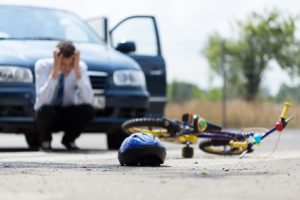
It seems that there have been many stories on the news lately about children who were tragically killed when a parent, neighbor, or other driver backed over them in the driveway, parking lot, or street. These types of auto accidents often lead to serious injuries or death for children and adults alike, and, they are happening across Pennsylvania, New Jersey, and Delaware.
These car accidents happen when a vehicle is reversing out of a parking spot or driveway. The victims of these accidents almost always are pedestrians or individuals riding a bike and the motor vehicle accident typically occurs at a low rate of speed. Although these types of accidents happen with all models of vehicles, there is a higher statistical probability that the vehicle will be an SUV or pick-up truck. This happens because there is a larger blind spot in these vehicles and trucks and SUVs are set higher off the road, with a greater undercarriage clearance.
Driver negligence often is the cause of these auto accidents, but there may be additional liability on the part of the property owner if a hazard on the property contributed to the accident. There could be bushes or other shrubbery growing high and close to the parking spot, blocking the views behind the vehicle. If the back-over accident happened in a parking lot, insufficient lighting may have decreased visibility and increased the odds of this type of accident. A thorough accident investigation is necessary to determine the various contributing factors that led to the accident.
For many years, it was difficult to obtain the actual number of backover accidents that happened each year because these accidents often occurred on private property. As such, law enforcement officers were not issuing tickets to the driver tickets for these types of accidents, so there was under-reporting of the incidents in state and federal databases. In 2009, the National Highway Traffic Safety Administration (NHTSA), at the urging of Congress, began to track backover accidents that happened in locations other than roads. The NHTSA now estimates that two-thirds of backover accidents each year happen in parking lots, driveways, or other off road properties. There are an estimated 183 fatalities as the result of backover accidents each year and between 6,700 and 7,419 injuries. Many of the victims of these auto accidents were minors. The significance of backover accidents and the harm that they cause is just becoming known.
There are two groups of people who are most at risk of suffering serious harm from a backover accident – children and the elderly. This is the case because of a propensity to move quickly into the path of a vehicle on the part of children and the inability to react quickly to get out of the way in elderly victims. In a study prepared for Congress, the NHTSA reports that there are backover prevention technologies that are marketed as safety devices, but that these have limited use because of poor accuracy in detecting children. Backup cameras were found to offer the best solutions, but the study reported that more evidence was necessary before conclusions could be drawn.
Victims of backover accidents often suffer from serious injuries. They also have a high statistical probability of falling within a group of people who may not be able to bring a lawsuit on their own. The complications of a backover accident increase when a friend or loved one was the person who caused the harm to the victim. The compassionate auto accident attorneys at Lundy Law understand that there are many difficulties that may exist in getting the compensation that you or your loved one deserves. We are dedicated to providing you with comprehensive legal counsel while listening to your concerns. We will fight to protect your interests with your input and involvement. We are here to answer your questions 24 hours a day, 7 days a week. Please call us at 1-800-LundyLaw, or complete our free online consultation form so that we can help you obtain the best legal outcome possible.
















